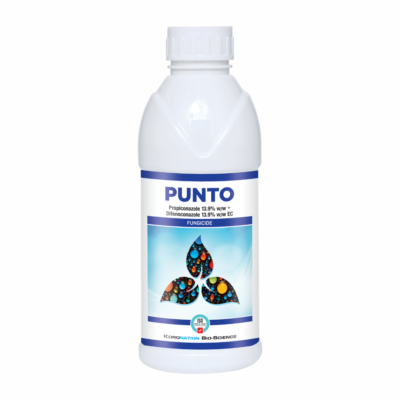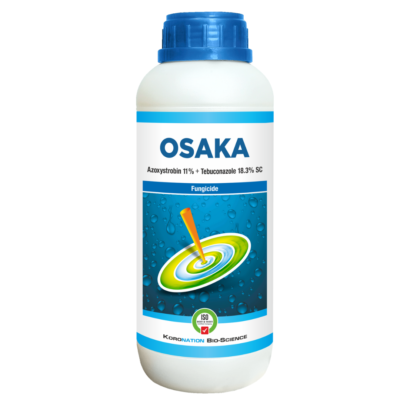Chemical Composition:
| S.No | Ingredient | Description | Weight |
| 1 | Thiamethoxam a.i. | 25.00 % w/w | |
| 2 | Thiophanate-methyl a.i. | 11.25 % w/w | |
| 3 | Azoxystrobin a.i. | 2.50 % w/w | |
| 4 | Polyalkylene oxide block copolymer | 2.50 % w/w | |
| 5 | Acrylic copolymer | 3.00 % w/w | |
| 6 | Sodium lignosulphonate | 0.50 % w/w | |
| 7 | Glycerin | 10.00 % w/w | |
| 8 | Propylene Glycol | 0.60 % w/w | |
| 9 | Nonionic aqueous emulsion of polydimethylsiloxane | 0.40 % w/w | |
| 10 | Calcium;(4Z)-4-[5-chloro-4-methyl-2- sulfonatophenyl)hydrazinylidene]-3-oxonaphthalene- 2-carboxylate | 2.00 % w/w | |
| 11 | Xanthan gum | 0.15 % w/w | |
| 12 | 1,2-Benzisothiazolin-3-one | 0.15 % w/w | |
| 13 | Water | Q.S. % | |
| Total | 100 % w/w | ||
Recommendation :
|
Crop(s) |
Common Name of Pest |
Dosage/HA |
Dilution in Water (Liter) |
Waiting Period between last spray to harvest (Days) |
Re-entry after each Application (In Hours) |
|
|
AI (gm) |
Formulation (ml) |
|||||
| Soybean | like fusarium root rot, phytophthora root rot, rhizoctonia seedling blight, pythium seedling blight and insect as shoot fly, white grub and termites | 38.75 | 100 | – | – | – |
Direction of Use
Seed to be treated should be put in a polythene bag, as per recommendation the desired quantity of pesticides should be poured on the seeds and the bag should be shaken to cover the seeds uniformly. Dry in shade post treatment and sow.
Time of Application :
Precaution:
Wash contaminated clothes and parts of the body after application. Wear full protective clothing during application. The applicant should use chemical resistant gloves and goggles face mask while dealing/doing seed dressing treatment. Avoid inhalation, do not smoke, drink, eat and chew anything during application. Colour of treated seed is pink red. Keep treated and untreated seed separately. Make sure treated and untreated seed should not mix.
Symptoms Of Poisoning:
Nausea, vomiting, diarrhea, abdominal pain, tremor, irritation to bronchi and lung, toxic convulsion may occur.
First Aid
- If ingestion: If person is conscious and alert, rinse mouth with water and give 1 or 2 glass of water to drink. Never give anything by mouth to an unconscious person. Call the doctor. Do not induced vomiting until and unless desired by attending physician.
- If inhaled: Take the patient to fresh air and take care of body temperature. It patient is not breathing or breathing with difficulty, give artificial respiration, preferably with mouth breathing. Consult a physician.
- In case of skin contact: Take off immediately all contaminated clothing. Wash with soap and plenty of water. If pain, redness or irritation persists, consult a doctor. All the contaminated clothes should be segregated and thoroughly washed with soap and water separately before use.
- In case of eye contact: Rinse gently with plenty of water at least 15 minutes. If pain, irritation, redness or photophobia persists, consult eye specialist.
Phytotoxicity
–
Antidote
No specific antidote is known. Treat symptomatically.
Disposal Of Used Container
- It shall be the duty of manufactures, formulators of insecticide and operators to dispose off packages or surplus materials and washings in a safe manner so as to prevent environmental and water pollution.
- The used packages shall not be left out side to prevent their re-use.
- The packages shall be broken and buried away from habitation.
Storage Conditions
- The packages containing pesticide shall be stored in separate rooms or premises, away from the rooms or premises used for storing other articles or shall be kept in separate almirahs under lock and key depending upon the quantity and nature of the pesticides.
- The store room should be well-built, well-lit, ventilated and sufficient in dimensions. The condition of the store should be dry and cool.
Caution:“Not to Be Used on Crops Other Than Specified on This Label/Leaflet”.







There are no reviews yet.